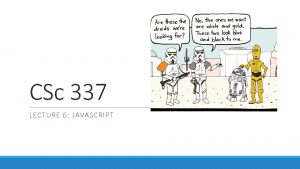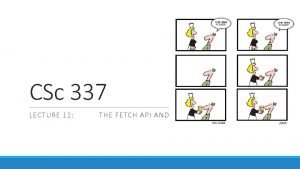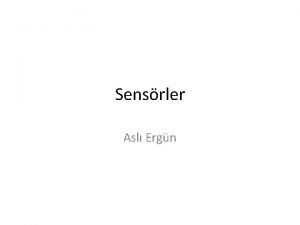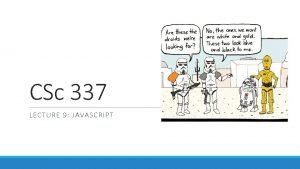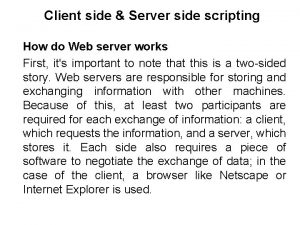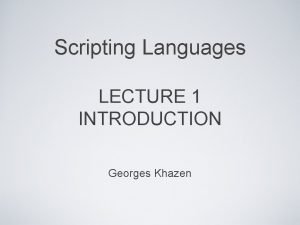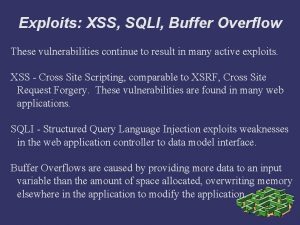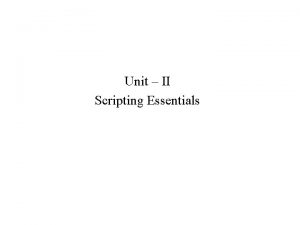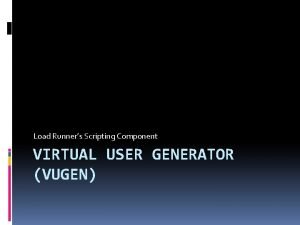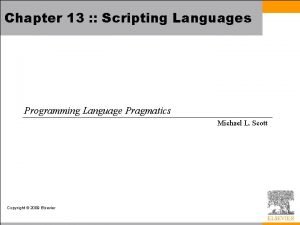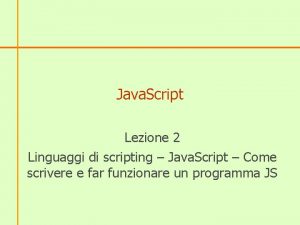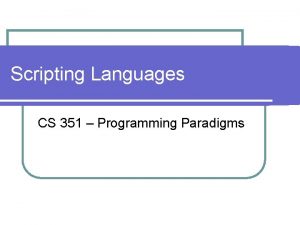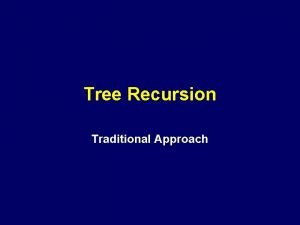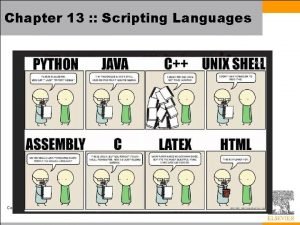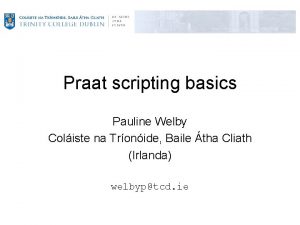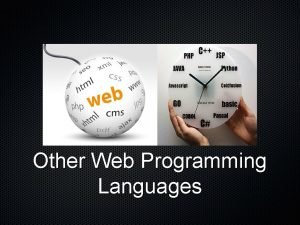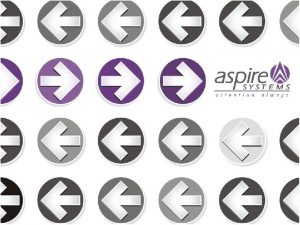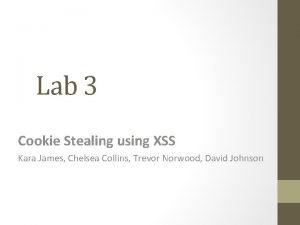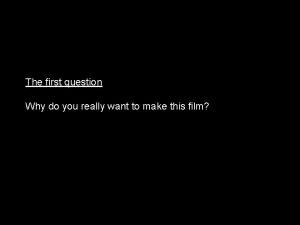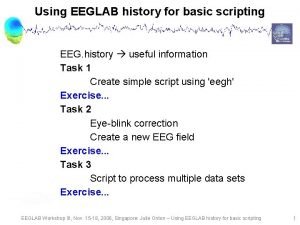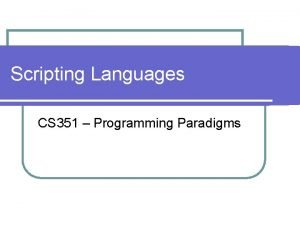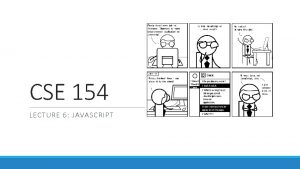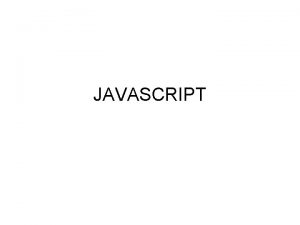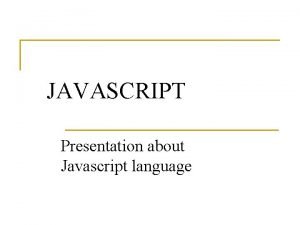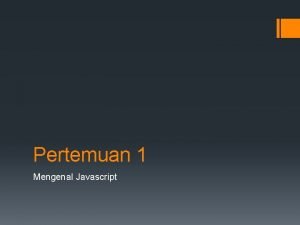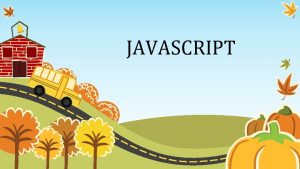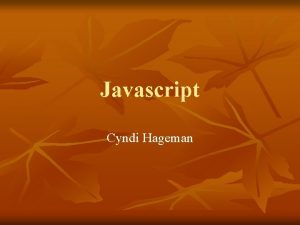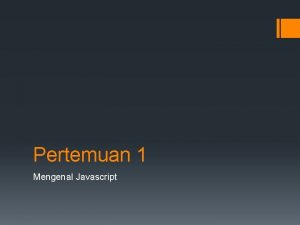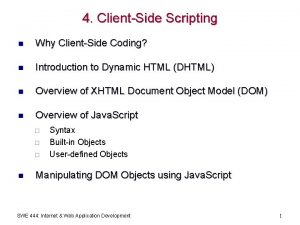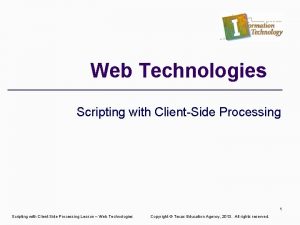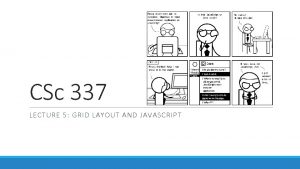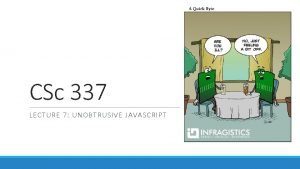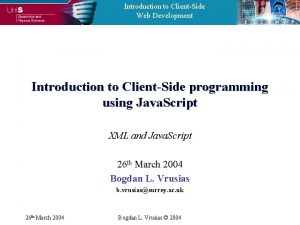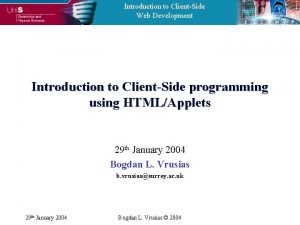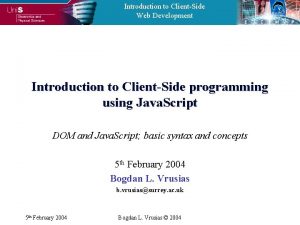CSc 337 LECTURE 6 JAVASCRIPT Clientside scripting clientside


















![Arrays var name = []; // empty array var name = [value, . . Arrays var name = []; // empty array var name = [value, . .](https://slidetodoc.com/presentation_image_h2/115edaaeeba7546ef03de6e7a6e84829/image-19.jpg)
![Array methods var a = ["Stef", "Jason"]; a. push("Brian"); a. unshift("Kelly"); a. pop(); a. Array methods var a = ["Stef", "Jason"]; a. push("Brian"); a. unshift("Kelly"); a. pop(); a.](https://slidetodoc.com/presentation_image_h2/115edaaeeba7546ef03de6e7a6e84829/image-20.jpg)




















- Slides: 40

CSc 337 LECTURE 6: JAVASCRIPT

Client-side scripting • client-side script: code runs in browser after page is sent back from server often this code manipulates the page or responds to user actions

What is Java. Script? • a lightweight programming language ("scripting language") • used to make web pages interactive § insert dynamic text into HTML (ex: user name) § react to events (ex: page load user click) § get information about a user's computer (ex: browser type) § perform calculations on user's computer (ex: form validation) • a web standard (but not supported identically by all browsers) • NOT related to Java other than by name and some syntactic similarities

Java. Script vs. Java • interpreted like Python, not compiled like Java • more relaxed syntax and rules § "looser" data types like Python § variables don't need to be declared like Python § errors often silent (few exceptions) + = Java. Script • key construct is the function rather than the class § "first-class" functions are used in many situations • contained within a web page and integrates with its HTML/CSS content

Linking to a Java. Script file: script <script src="filename" type="text/javascript"></script> HTML <script src="example. js" type="text/javascript"></script> HTML • script tag should be placed in HTML page's head • script code is stored in a separate. js file • JS code can be placed directly in the HTML file's body or head (like CSS) • but this is bad style (should separate content, presentation, and behavior)

A Java. Script statement: alert("message"); alert("IE 6 detected. JS Suck-mode enabled. "); JS output • a JS command that pops up a dialog box with a message

Variables and types var name = expression; var age = 32; var weight = 127. 4; var client. Name = "Connie Client"; JS JS • variables are declared with the var keyword (case sensitive) • types are not specified, but JS does have types ("loosely typed") • Number, Boolean, String, Array, Object, Function, Null, Undefined • can find out a variable's type by calling typeof

Number type var enrollment = 99; var median. Grade = 2. 8; var credits = 5 + 4 + (2 * 3); • integers and real numbers are the same type (no int vs. double) • same operators: + - * / % ++ -- = += -= *= /= %= • similar precedence to Java • many operators auto-convert types: "2" * 3 is 6 JS

String type var var s = "Connie Client"; f. Name = s. substring(0, s. index. Of(" ")); len = s. length; s 2 = 'Melvin Merchant'; // "Connie" // 13 // can use "" or ' ' • methods: char. At, char. Code. At, from. Char. Code, index. Of, last. Index. Of, replace, split, substring, to. Lower. Case, to. Upper. Case • char. At returns a one-letter String (there is no char type) • length property (not a method as in Java) • concatenation with + : 1 + 1 is 2, but "1" + 1 is "11"

More about String • escape sequences behave as in Java: ' " & n t \ • to convert between numbers and Strings: var var var count = 10; s 1 = "" + count; s 2 = count + " bananas, ah ah!"; n 1 = parse. Int("42 is the answer"); n 2 = parse. Float("booyah"); // // "10" "10 bananas, ah ah!" 42 Na. N • to access characters of a String, use [index] or char. At: var first. Letter = s[0]; var first. Letter = s. char. At(0); var last. Letter = s. char. At(s. length - 1);

Comments (same as Java ) // single-line comment /* multi-line comment */ • identical to Java's comment syntax • recall: 3 comment syntaxes • HTML: <!-- comment --> • CSS/JS: /* comment */ • Java/JS: // comment JS

for loop (same as Java) for (initialization; condition; update) { statements; } var sum = 0; for (var i = 0; i < 100; i++) { sum = sum + i; } var s 1 = "hello"; var s 2 = ""; for (var i = 0; i < s. length; i++) { s 2 += s 1[i] + s 1[i]; } // s 2 stores "hheelllloo“ JS JS JS

Math object var rand 1 to 10 = Math. floor(Math. random() * 10 + 1); var three = Math. floor(Math. PI); JS • methods: abs, ceil, cos, floor, log, max, min, pow, random, round, sin, sqrt, tan • properties: E, PI

Logical operators • Relational: > < >= <= • Logical: && || ! • Equality: == != === !== • most logical operators automatically convert types. These are all true: • 5 < "7" • 42 == 42. 0 • "5. 0" == 5 • The === and !== are strict equality tests; checks both type and value: • "5. 0" === 5 is false

Boolean type var i. Like. JS = true; var ie. Is. Good = "IE 6" > 0; if ("web dev is great") { if (0) { /* false */ } // false /* true */ } • any value can be used as a Boolean • "falsey" values: 0, 0. 0, Na. N, "", null, and undefined • "truthy" values: anything else • converting a value into a Boolean explicitly: • var bool. Value = Boolean(other. Value); • var bool. Value = !!(other. Value); JS

Special values: null and undefined var ned = null; var benson = 9; var caroline; // at this point in the code, // ned is null // benson's 9 // caroline is undefined • undefined : has not been declared, does not exist • null : exists, but was specifically assigned an empty or null value • Why does Java. Script have both of these? JS

if/else statement (same as Java) if (condition) { statements; } else { statements; } • identical structure to Java's if/else statement • Java. Script allows almost anything as a condition JS

while loops (same as Java) while (condition) { statements; } do { statements; } while (condition); JS JS • break and continue keywords also behave as in Java but do not use them in this class!
![Arrays var name empty array var name value Arrays var name = []; // empty array var name = [value, . .](https://slidetodoc.com/presentation_image_h2/115edaaeeba7546ef03de6e7a6e84829/image-19.jpg)
Arrays var name = []; // empty array var name = [value, . . . , value]; // pre-filled name[index] = value; // store element PHP var ducks = ["Huey", "Dewey", "Louie"]; var stooges = []; stooges[0] = "Larry"; stooges[1] = "Moe"; stooges[4] = "Curly"; stooges[4] = "Shemp"; // // // stooges. length is is is 0 1 2 5 5 • two ways to initialize an array • length property (grows as needed when elements are added) PHP
![Array methods var a Stef Jason a pushBrian a unshiftKelly a pop a Array methods var a = ["Stef", "Jason"]; a. push("Brian"); a. unshift("Kelly"); a. pop(); a.](https://slidetodoc.com/presentation_image_h2/115edaaeeba7546ef03de6e7a6e84829/image-20.jpg)
Array methods var a = ["Stef", "Jason"]; a. push("Brian"); a. unshift("Kelly"); a. pop(); a. shift(); a. sort(); // // // Stef, Jason, Brian Kelly, Stef, Jason, Stef JS • array serves as many data structures: list, queue, stack, . . . • methods: concat, join, pop, push, reverse, shift, slice, sort, splice, to. S tring, unshift • push and pop add / remove from back • unshift and shift add / remove from front • shift and pop return the element that is removed

Splitting strings: split and join var s = "the quick brown fox"; var a = s. split(" "); // ["the", "quick", "brown", "fox"] a. reverse(); // ["fox", "brown", "quick", "the"] s = a. join("!"); // "fox!brown!quick!the“ JS • split breaks apart a string into an array using a delimiter • can also be used with regular expressions surrounded by /: var a = s. split(/[ t]+/); • join merges an array into a single string, placing a delimiter between them

Defining functions function name() { statement ; . . . statement ; } JS function my. Function() { alert("Hello!"); alert("How are you? "); } JS • the above could be the contents of example. js linked to our HTML page • statements placed into functions can be evaluated in response to user events

Event-driven programming • JS programs have no main; they respond to user actions called events • event-driven programming: writing programs driven by user events

Event handlers <element attributes onclick="function(); ">. . . HTML <div onclick="my. Function(); ">Click me!</div> HTML Click me! • Java. Script functions can be set as event handlers • when you interact with the element, the function will execute • onclick is just one of many event HTML attributes we'll use HTML

Buttons: <button> the canonical clickable UI control (inline) <button onclick="my. Function(); ">Click me!</button> HTML output • button's text appears inside tag; can also contain images • To make a responsive button or other UI control: 1. choose the control (e. g. button) and event (e. g. mouse click) of interest 2. write a Java. Script function to run when the event occurs 3. attach the function to the event on the control

Accessing an element: document. get. Element. By. Id var name = document. get. Element. By. Id("id"); JS <img id="icon 01" src="images/octopus. jpg" alt="an animal" /> <button onclick="change. Image(); ">Click me!</button> HTML function change. Image() { var octopus. Image = document. get. Element. By. Id("icon 01"); octopus. Image. src = "images/kitty. gif"; } JS output • document. get. Element. By. Id returns the DOM object for an element with a given id

<input> <!-- 'q' happens to be the name of Google's required parameter --> <input type="text" name="q" value="Colbert Report" /> <input type="submit" value="Booyah!" /> HTML output • input element is used to create many UI controls • an inline element that MUST be self-closed • name attribute specifies name of query parameter to pass to server • type can be button, checkbox, file, hidden, password, radio, reset, submit, text, . . . • value attribute specifies control's initial text

Text fields: <input> <input type="text" size="10" maxlength="8" /> Net. ID <input type="password" size="16" /> Password <input type="submit" value="Log In" /> HTML output • input attributes: disabled, maxlength, readonly, size, value • size attribute controls onscreen width of text field • maxlength limits how many characters user is able to type into field

Text boxes: <textarea> a multi-line text input area (inline) <textarea rows="4" cols="20"> Type your comments here. </textarea> HTML output • initial text is placed inside textarea tag (optional) • required rows and cols attributes specify height/width in characters • optional readonly attribute means text cannot be modified

DOM properties form controls <input id="sid" type="text" size="7" maxlength="7" /> <input id="frosh" type="checkbox" checked="checked" /> Freshman? HTML var sid = document. get. Element. By. Id("sid"); var frosh = document. get. Element. By. Id("frosh"); JS output Property value checked disabled read. Only Description the text/value chosen by the user whether a box is checked whether a control is disabled (boolean) whether a text box is read-only Example sid. value could be "1234567" frosh. checked is true frosh. disabled is false sid. read. Only is false

Adjusting styles with the DOM object. Name. style. property. Name = "value"; <button onclick="color. It(); ">Click me!</button> <span id="fancytext">Don't forget your homework!</span> function color. It() { var text = document. get. Element. By. Id("fancytext"); text. style. color = "#ff 5500"; text. style. font. Size = "40 pt"; } JS HTML JS output Property style Description lets you set any CSS style property for an element • same properties as in CSS, but with camel. Cased. Names, not names-with-underscores • examples: background. Color, border. Left. Width, font. Family

Common DOM styling errors • many students forget to write. style when setting styles var click. Me = document. get. Element. By. Id("clickme"); click. Me. color = "red"; click. Me. style. color = "red"; JS • style properties are capitalized like. This, not like-this click. Me. style. font-size = "14 pt"; click. Me. style. font. Size = "14 pt"; JS • style properties must be set as strings, often with units at the end click. Me. style. width = 200; click. Me. style. width = "200 px"; click. Me. style. padding = "0. 5 em"; • write exactly the value you would have written in the CSS, but in quotes JS

Unobtrusive Java. Script • Java. Script event code seen previously was obtrusive, in the HTML; this is bad style • now we'll see how to write unobtrusive Java. Script code • HTML with no Java. Script code inside the tags • uses the JS DOM to attach and execute all Java. Script event handlers • allows separation of web site into 3 major categories: • content (HTML) - what is it? • presentation (CSS) - how does it look? • behavior (Java. Script) - how does it respond to user interaction?

Obtrusive event handlers (bad) <button onclick="okay. Click(); ">OK</button> // called when OK button is clicked function okay. Click() { alert("booyah"); } HTML JS output • this is bad style (HTML is cluttered with JS code) • goal: remove all Java. Script code from the HTML body

Attaching an event handler in Java. Script code object. Name. onevent = function; <button id="ok">OK</button> var ok. Button = document. get. Element. By. Id("ok"); ok. Button. onclick = okay. Click; JS HTML JS • it is legal to attach event handlers to elements' DOM objects in your Java. Script code • notice that you do not put parentheses after the function's name • this is better style than attaching them in the HTML

When does my code run? <html> <head> <script src="myfile. js" type="text/javascript"></script> </head> <body>. . . </body> </html> HTML var x = 3; function f(n) { return n + 1; } function g(n) { return n - 1; } x = f(x); JS • your file's JS code runs the moment the browser loads the script tag • any variables are declared immediately • any functions are declared but not called, unless your global code explicitly calls them • at this point in time, the browser has not yet read your page's body • none of the DOM objects for tags on the page have been created yet

A failed attempt at being unobtrusive <html> <head> <script src="myfile. js" type="text/javascript"></script> </head> <body> <div><button id="ok">OK</button></div> HTML var ok = document. get. Element. By. Id("ok"); ok. onclick = okay. Click; // error: null • problem: global JS code runs the moment the script is loaded • script in head is processed before page's body has loaded • no elements are available yet or can be accessed yet via the DOM • we need a way to attach the handler after the page has loaded. . . JS

The window. onload event function. Name() { // code to initialize the page. . . } // run this function once the page has finished loading window. onload = function. Name; • there is a global event called window. onload event that occurs at the moment the page body is done being loaded • if you attach a function as a handler for window. onload, it will run at that time

An unobtrusive event handler <button id="ok">OK</button> <!-- (1) --> HTML // called when page loads; sets up event handlers function page. Load() { var ok = document. get. Element. By. Id("ok"); // (3) ok. onclick = okay. Click; } function okay. Click() { alert("booyah"); } // (4) window. onload = page. Load; // (2) JS output

Common unobtrusive JS errors • event names are all lowercase, not capitalized like most variables window. on. Load = page. Load; window. onload = page. Load; • you shouldn't write () when attaching the handler (if you do, it calls the function immediately, rather than setting it up to be called later) ok. onclick = okay. Click(); ok. onclick = okay. Click; § our JSLint checker will catch this mistake • related: can't directly call functions like alert; must enclose in your own function ok. onclick = alert("booyah"); ok. onclick = okay. Click; function okay. Click() { alert("booyah"); }
 Csc 337
Csc 337 Csc 337
Csc 337 01:640:244 lecture notes - lecture 15: plat, idah, farad
01:640:244 lecture notes - lecture 15: plat, idah, farad Fritzing load cell
Fritzing load cell Form 337
Form 337 337 form example
337 form example 337 info
337 info 337 form example
337 form example Advantages of client side scripting
Advantages of client side scripting Strongly typed scripting language
Strongly typed scripting language Common cause of buffer overflow cross-site scripting
Common cause of buffer overflow cross-site scripting Business object interface
Business object interface Jmp scripting
Jmp scripting What is scripting
What is scripting Loadrunner scripting language
Loadrunner scripting language Explain the innovative features of scripting languages.
Explain the innovative features of scripting languages. Tabular editor perspectives
Tabular editor perspectives Linguaggi di scripting
Linguaggi di scripting Birt scripting
Birt scripting What is scripting
What is scripting Scripting image
Scripting image Inventor scripting
Inventor scripting Procedural literacy
Procedural literacy Paraview python scripting
Paraview python scripting Papercut print scripting
Papercut print scripting Lab 10-2: basics of scripting
Lab 10-2: basics of scripting Microsoft agent scripting helper
Microsoft agent scripting helper Innovative features of scripting languages
Innovative features of scripting languages Elongday
Elongday Praat scripting tutorial
Praat scripting tutorial Scripting image
Scripting image Language
Language Linear scripting framework
Linear scripting framework Cookie stealing script for facebook
Cookie stealing script for facebook Papercut print scripting
Papercut print scripting Papercut print scripting
Papercut print scripting Gelscripting
Gelscripting Shifting script template
Shifting script template Eeglab scripting
Eeglab scripting Common characteristics of scripting languages
Common characteristics of scripting languages Lumerical scripting language
Lumerical scripting language
